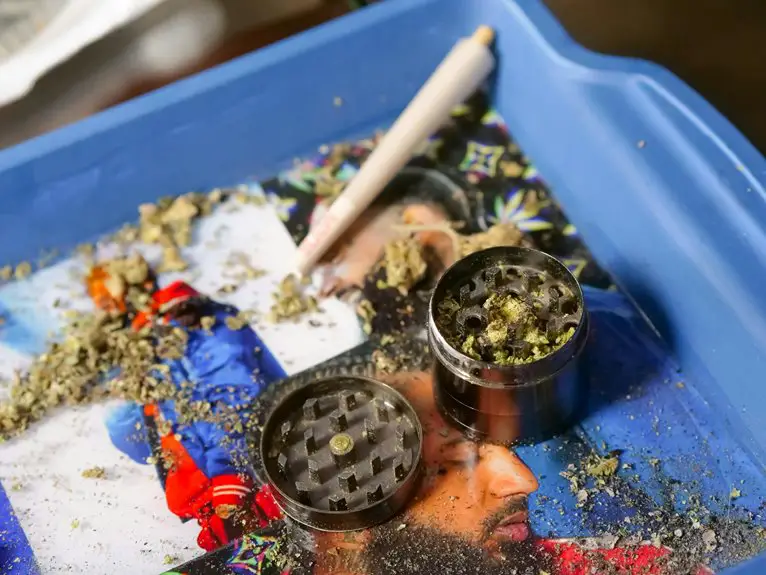You use soda ash in dyeing to raise the pH and activate the fabric’s fibers, helping reactive dyes bond firmly for vibrant, long-lasting color. It swells fibers, allowing dyes to penetrate deeply while reducing dye loss. Too little soda ash leads to faded colors; too much can harm fabrics and cause uneven dyeing. Proper measurement and mixing are key for consistent results. Keep exploring to understand how it impacts dye quality and the environment.
Table of Contents
Key Takeaways
- Soda ash raises the dye bath pH, activating reactive dyes for strong bonding and vibrant color fixation.
- It causes fabric fibers to swell, improving dye penetration and ensuring deeper color integration.
- Proper soda ash concentration is crucial; too little fades colors, too much risks uneven dyeing and fabric damage.
- Thorough mixing and accurate measurement prevent uneven dye absorption and maintain consistent dye quality.
- Post-dyeing rinsing removes residual soda ash, preserving fabric feel and enhancing colorfastness.
Chemical Properties of Soda Ash
Soda ash, also known as sodium carbonate, plays an essential role in the dyeing process due to its unique chemical properties.
When you use soda ash, you’re working with a strong alkaline compound that raises the pH level of the dye bath. This shift creates an environment where many dyes, especially reactive ones, bond more effectively with fibers.
You’ll find that soda ash’s ability to neutralize acids helps balance the solution, ensuring consistent dye uptake. Plus, its solubility in water means it disperses evenly, making the dyeing process smoother.
How Soda Ash Interacts With Fabric Fibers
When you add soda ash during dyeing, it changes the chemistry of the fabric fibers, making them more receptive to the dye.
It also adjusts the pH balance, creating the right environment for the dye to bond effectively.
Understanding these interactions helps you achieve vibrant and long-lasting colors.
Fiber Chemistry Alteration
Although you mightn’t notice it, adding soda ash during dyeing triggers important chemical changes in fabric fibers. When you introduce soda ash, it increases the alkalinity, which causes the fibers—especially cellulose in cotton—to swell.
This swelling opens up the fiber structure, allowing dye molecules to penetrate more easily. Soda ash also promotes the conversion of certain fiber groups into reactive forms, enabling stronger bonds with the dye.
These chemical alterations improve dye uptake and fixation, enhancing color vibrancy and durability. By altering the fiber chemistry, soda ash guarantees dyes don’t just sit on the surface but integrate deeply within the fabric.
Ph Balance Adjustment
Because the pH level directly affects how dyes bond with fabric fibers, adjusting it precisely is crucial during dyeing.
When you add soda ash, you raise the pH, making the solution more alkaline. This shift helps open up the fibers, allowing dyes to penetrate more deeply and bond more effectively.
Without the right pH balance, dyes may not fix properly, leading to uneven coloring or fading. Soda ash also neutralizes any acidity in the dye bath, stabilizing the environment for consistent results.
By controlling pH with soda ash, you guarantee the dye molecules interact efficiently with the fabric, enhancing color vibrancy and durability.
Soda Ash’s Role in Fixing Reactive Dyes
When you use soda ash with reactive dyes, it helps the dye bond strongly to the fabric by adjusting the pH to the right level.
This pH adjustment is essential because it activates the dye’s reactive groups, ensuring a firm attachment.
As a result, your colors will stay vibrant and resist fading much better over time.
Enhancing Dye Bonding
Three key factors determine the quality of dye bonding in textile processing, and soda ash plays an essential role in one of them.
When you use soda ash, you enhance the fixation of reactive dyes, ensuring a strong chemical bond between dye molecules and fabric fibers. This improves colorfastness and vibrancy.
Here’s how soda ash helps:
- Activates Reactive Groups: It raises the pH, activating dye groups to react with fibers.
- Promotes Covalent Bond Formation: It facilitates a stable, permanent bond between dye and fabric.
- Reduces Dye Hydrolysis: It minimizes dye loss by preventing premature dye breakdown in water.
Ph Adjustment Importance
While dye fixation depends on several factors, adjusting the pH with soda ash is crucial for guaranteeing reactive dyes bond effectively to fabric fibers.
When you add soda ash, it raises the solution’s pH, creating an alkaline environment that activates the reactive groups in the dye. This activation allows the dye to chemically bond with the cellulose in cotton and other fibers.
Without the right pH, you risk incomplete fixation, leading to weak color and uneven dyeing. You’ll want to carefully control the amount of soda ash, as too much can damage fibers or cause dye hydrolysis, where dye reacts with water instead of fabric.
Improving Color Fastness
Because soda ash creates the perfect alkaline environment, it plays a key role in improving the color fastness of reactive dyes. When you use soda ash, it helps fix the dye molecules onto the fabric more securely, preventing fading and washing out.
Here’s how it works:
- Enhances Dye-Fiber Bonding: Soda ash increases the pH, allowing reactive dyes to chemically bond with cellulose fibers effectively.
- Reduces Dye Bleeding: By improving fixation, it minimizes dye loss during washing or exposure to light.
- Improves Durability: The stronger bond formed means colors stay vibrant longer, even after repeated laundering.
Impact of Soda Ash Concentration on Dye Quality
When you adjust the concentration of soda ash in the dyeing process, you directly influence the quality and consistency of the color achieved. Too little soda ash can cause poor fixation, resulting in washed-out colors, while too much may lead to uneven dye uptake or fabric damage. Finding the right balance guarantees vibrant, uniform shades and enhances dye adherence.
| Soda Ash Level | Effect on Dye Quality | Recommended Use |
|---|---|---|
| Low | Faded colors, poor fixation | Light fabrics, delicate dyes |
| Medium | Vibrant, consistent colors | Most dyeing applications |
| High | Risk of uneven dyeing | Heavy fabrics, stronger dyes |
Differences Between Soda Ash and Other Fixatives
Adjusting soda ash levels clearly impacts dye quality, but it’s also important to understand how soda ash compares to other fixatives used in the dyeing process.
Unlike acidic fixatives, soda ash raises the pH, which helps reactive dyes bond with fibers more effectively.
Here’s how soda ash differs from other common fixatives:
- Chemical action: Soda ash activates fiber sites for dye bonding, while fixatives like cationic agents neutralize negative charges to improve dye uptake.
- Application timing: You add soda ash during dyeing for fixation, whereas some fixatives are applied post-dyeing to enhance colorfastness.
- Compatibility: Soda ash works best with reactive dyes on cellulose fibers, while other fixatives suit different dye classes or fiber types.
Knowing these differences helps you optimize your dyeing results.
Environmental Considerations in Using Soda Ash
Three key environmental factors come into play when you use soda ash in dyeing.
First, its alkalinity can raise the pH of wastewater, which may harm aquatic life if not properly neutralized. You need to guarantee effluents are treated before release.
Second, soda ash production involves energy-intensive processes that contribute to carbon emissions, so opting for suppliers with greener practices helps reduce your environmental footprint.
Third, overuse of soda ash can increase water hardness, affecting soil quality if wastewater is reused for irrigation.
Common Challenges When Using Soda Ash in Dyeing
Although soda ash is essential for achieving vibrant dye colors, you’ll often face challenges that can affect the quality and consistency of your results.
Soda ash is key for vibrant colors but can pose challenges that impact dye quality and consistency.
Getting the pH level just right is critical, but it can be tricky since too much soda ash leads to harsh fabrics or uneven dye uptake. Water hardness also interferes, causing unpredictable reactions with the soda ash. Additionally, improper mixing can result in patchy coloration.
Here are common challenges you might encounter:
- pH Imbalance: Excess soda ash raises pH too high, damaging fibers and altering colors.
- Water Hardness: Minerals in hard water react with soda ash, affecting dye solubility.
- Uneven Distribution: Poor mixing causes inconsistent dye absorption and blotchy patterns.
Being aware of these issues helps you troubleshoot and improve your dyeing outcomes.
Best Practices for Incorporating Soda Ash in Textile Dyeing
To get the best results with soda ash in your dyeing process, you need to manage its use carefully to avoid problems like pH imbalance and uneven color.
Always measure soda ash accurately based on your fabric type and dye concentration. Dissolve it fully in warm water before adding it to your dye bath to guarantee even distribution.
Add soda ash gradually rather than all at once; this helps maintain stable pH levels and prevents fabric damage. Stir the dye bath consistently to keep the soda ash and dye molecules evenly mixed.
After dyeing, rinse the fabric thoroughly to remove any residual soda ash, which could affect fabric feel or colorfastness.
Frequently Asked Questions
Can Soda Ash Be Used in Natural Fabric Dyeing?
Yes, you can use soda ash in natural fabric dyeing. It helps fix the dye to fibers, especially cellulose fabrics like cotton, making colors brighter and more permanent. Just be sure to handle it carefully.
What Safety Precautions Are Needed When Handling Soda Ash?
You might underestimate soda ash’s power, but don’t! Wear gloves and goggles, work in a ventilated space, avoid inhaling dust, and wash hands thoroughly. Taking these steps keeps you safe while handling it confidently.
How Does Soda Ash Affect Dyeing Time?
You’ll find soda ash speeds up dyeing time by raising fabric pH, which helps dye molecules bond faster. This means your dye sets more quickly, improving efficiency without sacrificing color quality or consistency.
Is Soda Ash Suitable for All Types of Reactive Dyes?
You shouldn’t use soda ash with all reactive dyes because some require different pH levels. It works well with vinyl sulfone and some other types but may damage dyes needing milder conditions or acids.
Can Soda Ash Be Recycled or Reused in Dyeing Processes?
You can’t easily recycle or reuse soda ash in dyeing because it gets contaminated with dyes and chemicals. Instead, it’s best to handle waste properly to avoid environmental harm and guarantee effective dyeing results.
- Can You Steam Lyocell? The Best Way to De-Wrinkle Your Garments - July 14, 2025
- Is Lyocell Toxic? A Look at the Safety of This Eco-Friendly Fabric - July 14, 2025
- What Is Lyocell Fabric? Pros, Cons, and Common Uses - July 14, 2025







